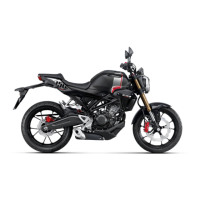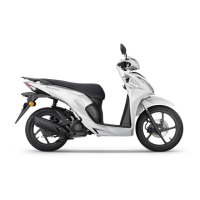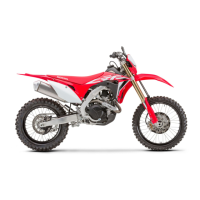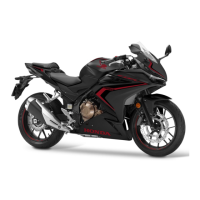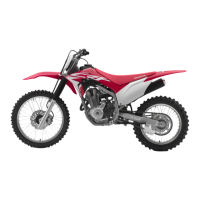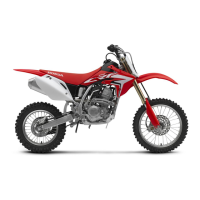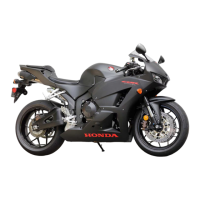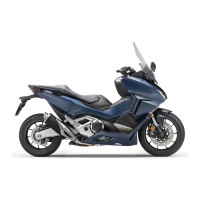Do you have a question about the Honda BeAT 2020 and is the answer not in the manual?
Details about the Customer Relation Section and its purpose.
Contact methods and working hours for the Customer Relation Section.
Congratulates the owner and emphasizes reading the manual for safety.
Identifies the country code for the vehicle and its meaning.
Essential guidelines for safe riding, including helmet use and defensive riding.
Explains the meaning of various warning and information labels on the vehicle.
Detailed precautions for riding, including protective apparel and helmet requirements.
Guidelines for safe riding, covering running-in, braking, and wet conditions.
Advises against unauthorized accessories and modifications due to safety risks.
Provides guidance on maximum weight capacity and proper luggage loading.
Outlines the sequence for starting, riding, and stopping the vehicle.
Details the function of the speedometer, odometer, and fuel gauge.
Describes the meaning and function of various dashboard indicators and warning lamps.
Explains the operation of key switches like ignition, lights, horn, and turn signals.
Instructions on how to lock the steering and use the ignition switch shutter for theft prevention.
Explains the function, activation, and troubleshooting of the idling stop system.
Step-by-step procedure for starting the engine using the start button or kickstarter.
Guidance on starting to ride, acceleration, deceleration, and proper braking techniques.
Details on fuel type, tank capacity, and how to open and close the fuel filler cap.
Information on the location and proper use of the accessory socket for charging devices.
Instructions on accessing and using the seat, helmet holders, and luggage compartments.
Explains why regular maintenance is crucial for safety, performance, and longevity.
Provides a detailed schedule of recommended maintenance tasks and intervals.
Covers essential maintenance procedures like pre-ride inspections and part replacement.
Guidance on battery care, cleaning terminals, and replacement.
Procedures for checking tyre pressure, damage, wear, and replacement guidelines.
Steps for checking engine oil level and adding oil if necessary.
Instructions for inspecting front and rear brake fluid, pads, and lever freeplay.
Addresses problems with engine starting, idling stop system, and unstable operation.
Explains the meaning of dashboard warning lights like PGM-FI and fuel gauge failures.
Guidance on how to perform an emergency tyre repair and when to seek professional help.
Covers common electrical issues like dead batteries, blown bulbs, and fuses.
Details on ignition keys, their numbers, and ignition switch operation.
Guidelines for washing, polishing, and general care of the vehicle.
Procedures for storing the vehicle and safe methods for transportation.
Information on vehicle impact on the environment and fuel recommendations.
Advice on protecting the catalytic converter and maintaining engine performance.
Key physical dimensions, weight, and capacity details of the vehicle.
Technical data for tyres, spark plugs, engine oil, brake fluid, and capacities.
Specifications for vehicle bulbs and fuse ratings for replacement.
Details about the Customer Relation Section and its purpose.
Contact methods and working hours for the Customer Relation Section.
Congratulates the owner and emphasizes reading the manual for safety.
Identifies the country code for the vehicle and its meaning.
Essential guidelines for safe riding, including helmet use and defensive riding.
Explains the meaning of various warning and information labels on the vehicle.
Detailed precautions for riding, including protective apparel and helmet requirements.
Guidelines for safe riding, covering running-in, braking, and wet conditions.
Advises against unauthorized accessories and modifications due to safety risks.
Provides guidance on maximum weight capacity and proper luggage loading.
Outlines the sequence for starting, riding, and stopping the vehicle.
Details the function of the speedometer, odometer, and fuel gauge.
Describes the meaning and function of various dashboard indicators and warning lamps.
Explains the operation of key switches like ignition, lights, horn, and turn signals.
Instructions on how to lock the steering and use the ignition switch shutter for theft prevention.
Explains the function, activation, and troubleshooting of the idling stop system.
Step-by-step procedure for starting the engine using the start button or kickstarter.
Guidance on starting to ride, acceleration, deceleration, and proper braking techniques.
Details on fuel type, tank capacity, and how to open and close the fuel filler cap.
Information on the location and proper use of the accessory socket for charging devices.
Instructions on accessing and using the seat, helmet holders, and luggage compartments.
Explains why regular maintenance is crucial for safety, performance, and longevity.
Provides a detailed schedule of recommended maintenance tasks and intervals.
Covers essential maintenance procedures like pre-ride inspections and part replacement.
Guidance on battery care, cleaning terminals, and replacement.
Procedures for checking tyre pressure, damage, wear, and replacement guidelines.
Steps for checking engine oil level and adding oil if necessary.
Instructions for inspecting front and rear brake fluid, pads, and lever freeplay.
Addresses problems with engine starting, idling stop system, and unstable operation.
Explains the meaning of dashboard warning lights like PGM-FI and fuel gauge failures.
Guidance on how to perform an emergency tyre repair and when to seek professional help.
Covers common electrical issues like dead batteries, blown bulbs, and fuses.
Details on ignition keys, their numbers, and ignition switch operation.
Guidelines for washing, polishing, and general care of the vehicle.
Procedures for storing the vehicle and safe methods for transportation.
Information on vehicle impact on the environment and fuel recommendations.
Advice on protecting the catalytic converter and maintaining engine performance.
Key physical dimensions, weight, and capacity details of the vehicle.
Technical data for tyres, spark plugs, engine oil, brake fluid, and capacities.
Specifications for vehicle bulbs and fuse ratings for replacement.
| Engine Type | 4-stroke, SOHC, eSP |
|---|---|
| Displacement | 108.2 cc |
| Ignition System | Full Transistorized |
| Transmission Type | Automatic, V-Matic |
| Front Suspension | Telescopic Fork |
| Rear Suspension | Unit Swing |
| Seat Height | 740 mm |
| Frame Type | Underbone |
| Front Tire | 80/90-14M/C 40P |
| Rear Tire | 90/90-14M/C 46P |
| Wheelbase | 1, 256 mm |
| Ground Clearance | 146 mm |
| Max Power | 7, 500 rpm |
| Max Torque | 6, 000 rpm |
| Fuel System | PGM-FI |
| Front Brake | Hydraulic Disc |
| Rear Brake | Drum |
| Curb Weight | 90 kg |
| Starting System | Electric starter |

